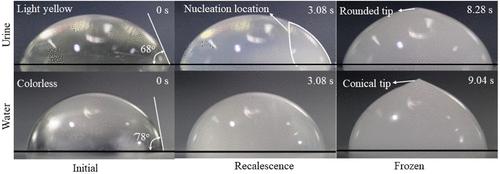Our official English website, www.x-mol.net, welcomes your
feedback! (Note: you will need to create a separate account there.)
Experimental Study on Solidification Characteristics of Sessile Urine Droplets on a Horizontal Cold Plate Surface under Natural Convection
Langmuir ( IF 3.7 ) Pub Date : 2022-06-13 , DOI: 10.1021/acs.langmuir.2c01154 Qun Dang 1 , Mengjie Song 1 , Chaobin Dang 2 , Tianzhuo Zhan 3 , Long Zhang 1
Langmuir ( IF 3.7 ) Pub Date : 2022-06-13 , DOI: 10.1021/acs.langmuir.2c01154 Qun Dang 1 , Mengjie Song 1 , Chaobin Dang 2 , Tianzhuo Zhan 3 , Long Zhang 1
Affiliation

|
As the human excreta, urine is often used as one of the test materials in medical research due to its composition and content directly reflecting the health status of the body. Considering that the substances in urine may show different effects on its freezing process, solidification characteristics of sessile urine droplets on a horizontal cold plate surface under natural convection were experimentally investigated by comparing with those of water droplets under same conditions. To make the conclusion analysis more reasonable, the urine of a human without any diseases, especially metabolic diseases, was treated and used. The characteristics include nucleation location, dynamic variation of droplet color, and temperatures at different heights inside the droplet, and so forth. It was found that, similar to that of a water droplet, the solidification process of a urine droplet also experiences the following four stages: supercooling, recalescence, freezing, and cooling, in chronological order. Differently, the urine droplet changes from transparent to blur white at the supercooling stage due to the precipitation of inorganic salts. For nucleation locations, 46.67% cases are at the bottom, while others are at the top and middle of urine droplets. For a 10 μL droplet on a surface of −30 °C, urine has a 0.95 s freezing duration shorter than water, and a 5.31 °C lower phase-transition temperature. Results of this study are expected to reflect the content of substances in urine and thus provide references for urinalysis of patients with metabolic diseases.
中文翻译:

自然对流下水平冷板表面固着尿滴凝固特性的实验研究
尿液作为人体排泄物,因其成分和含量直接反映了人体的健康状况,常被用作医学研究的检验材料之一。考虑到尿液中的物质对其冷冻过程的影响可能不同,通过与相同条件下水滴的比较,实验研究了自然对流下无柄尿滴在水平冷板表面的凝固特性。为了使结论分析更加合理,对没有任何疾病,特别是代谢疾病的人的尿液进行了处理和使用。其特征包括成核位置、液滴颜色的动态变化以及液滴内部不同高度处的温度等。结果发现,类似于水滴,尿滴的凝固过程也经历了以下四个阶段:过冷、回热、冻结和冷却,按时间顺序排列。不同的是,由于无机盐的沉淀,尿滴在过冷阶段由透明变为模糊的白色。对于成核位置,46.67%的病例在底部,而其他的则在尿滴的顶部和中间。对于 -30 °C 表面上的 10 μL 液滴,尿液的冷冻持续时间比水短 0.95 s,相变温度低 5.31 °C。本研究结果有望反映尿液中物质的含量,为代谢性疾病患者的尿液分析提供参考。按年代顺序。不同的是,由于无机盐的沉淀,尿滴在过冷阶段由透明变为模糊的白色。对于成核位置,46.67%的病例在底部,而其他的则在尿滴的顶部和中间。对于 -30 °C 表面上的 10 μL 液滴,尿液的冷冻持续时间比水短 0.95 s,相变温度低 5.31 °C。本研究结果有望反映尿液中物质的含量,为代谢性疾病患者的尿液分析提供参考。按年代顺序。不同的是,由于无机盐的沉淀,尿滴在过冷阶段由透明变为模糊的白色。对于成核位置,46.67%的病例在底部,而其他的则在尿滴的顶部和中间。对于 -30 °C 表面上的 10 μL 液滴,尿液的冷冻持续时间比水短 0.95 s,相变温度低 5.31 °C。本研究结果有望反映尿液中物质的含量,为代谢性疾病患者的尿液分析提供参考。而另一些则在尿滴的顶部和中间。对于 -30 °C 表面上的 10 μL 液滴,尿液的冷冻持续时间比水短 0.95 s,相变温度低 5.31 °C。本研究结果有望反映尿液中物质的含量,为代谢性疾病患者的尿液分析提供参考。而另一些则在尿滴的顶部和中间。对于 -30 °C 表面上的 10 μL 液滴,尿液的冷冻持续时间比水短 0.95 s,相变温度低 5.31 °C。本研究结果有望反映尿液中物质的含量,为代谢性疾病患者的尿液分析提供参考。
更新日期:2022-06-13
中文翻译:

自然对流下水平冷板表面固着尿滴凝固特性的实验研究
尿液作为人体排泄物,因其成分和含量直接反映了人体的健康状况,常被用作医学研究的检验材料之一。考虑到尿液中的物质对其冷冻过程的影响可能不同,通过与相同条件下水滴的比较,实验研究了自然对流下无柄尿滴在水平冷板表面的凝固特性。为了使结论分析更加合理,对没有任何疾病,特别是代谢疾病的人的尿液进行了处理和使用。其特征包括成核位置、液滴颜色的动态变化以及液滴内部不同高度处的温度等。结果发现,类似于水滴,尿滴的凝固过程也经历了以下四个阶段:过冷、回热、冻结和冷却,按时间顺序排列。不同的是,由于无机盐的沉淀,尿滴在过冷阶段由透明变为模糊的白色。对于成核位置,46.67%的病例在底部,而其他的则在尿滴的顶部和中间。对于 -30 °C 表面上的 10 μL 液滴,尿液的冷冻持续时间比水短 0.95 s,相变温度低 5.31 °C。本研究结果有望反映尿液中物质的含量,为代谢性疾病患者的尿液分析提供参考。按年代顺序。不同的是,由于无机盐的沉淀,尿滴在过冷阶段由透明变为模糊的白色。对于成核位置,46.67%的病例在底部,而其他的则在尿滴的顶部和中间。对于 -30 °C 表面上的 10 μL 液滴,尿液的冷冻持续时间比水短 0.95 s,相变温度低 5.31 °C。本研究结果有望反映尿液中物质的含量,为代谢性疾病患者的尿液分析提供参考。按年代顺序。不同的是,由于无机盐的沉淀,尿滴在过冷阶段由透明变为模糊的白色。对于成核位置,46.67%的病例在底部,而其他的则在尿滴的顶部和中间。对于 -30 °C 表面上的 10 μL 液滴,尿液的冷冻持续时间比水短 0.95 s,相变温度低 5.31 °C。本研究结果有望反映尿液中物质的含量,为代谢性疾病患者的尿液分析提供参考。而另一些则在尿滴的顶部和中间。对于 -30 °C 表面上的 10 μL 液滴,尿液的冷冻持续时间比水短 0.95 s,相变温度低 5.31 °C。本研究结果有望反映尿液中物质的含量,为代谢性疾病患者的尿液分析提供参考。而另一些则在尿滴的顶部和中间。对于 -30 °C 表面上的 10 μL 液滴,尿液的冷冻持续时间比水短 0.95 s,相变温度低 5.31 °C。本研究结果有望反映尿液中物质的含量,为代谢性疾病患者的尿液分析提供参考。







































 京公网安备 11010802027423号
京公网安备 11010802027423号